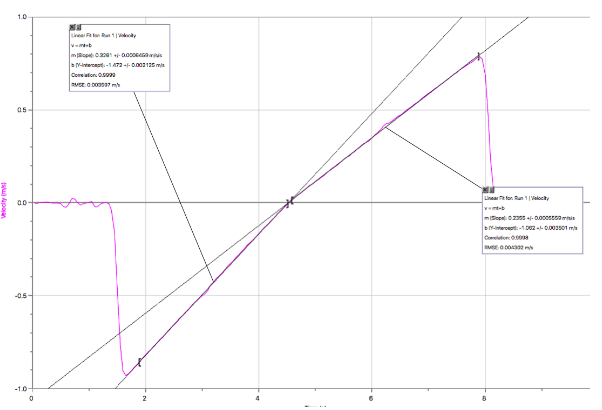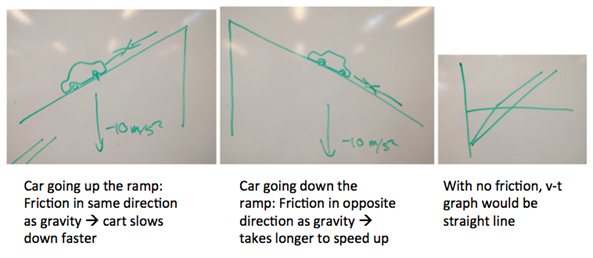Ramps – Background
Class
Colleen Nyeggen teaches an introductory algebra-based physics course at a west coast private high school. This class is comprised of 18 11th graders and meets every other day for 75 minutes. As the syllabus explains, students “engage in group discussions to explore complex ideas and build consensus around those ideas.”
Episode
Near the beginning of the acceleration unit, students explored the motion of a cart pushed up a ramp and allowed to come back down. They used digital motion detectors to measure the cart’s position and velocity; the software graphed the results. After a day in the lab collecting motion graphs, students shared their observations with each other. One group reported an “anomaly” in their velocity graph: It was almost a straight line, but the graph of the cart going up the ramp had a slightly steeper slope than the graph of the cart going.
The rest of the class was intrigued, so the teacher made the “anomaly graph” a focus of study for several days. Other groups were able to identify the “anomaly” in their own graphs, too, and the teacher led the class in discussing and designing experiments to test possible explanations. The class shared and discussed their results, for round one of investigation.
For homework, students wrote their “current best explanation” for the anomaly, and the next day students shared their ideas. David P shared that he thought the anomaly was due to friction and drew a diagram on the board showing that when the cart is going up the ramp, friction is in the same direction as gravity, but when the cart is going down the ramp, friction is in the opposite direction of gravity. According to David, this would result in a different acceleration for each half of the motion which would explain why the slope of the velocity graph changes.
The rest of the class thought this explanation made a lot of sense, so the teacher asked students to design a second round of experiments, this time to test whether friction is causing the anomaly.
These were the groups’ experiments and results:
- The “WD-40 Group” added WD-40 to the cart’s wheel axles and found the anomaly went away.
- The “Weight Group” added mass to the cart, expecting the anomaly to be more pronounced. Their results were inconclusive and became a focus of attention.
- The “Increase Air Resistance Group” taped cardboard parachutes of varying sizes to the cart,, and saw the anomaly increase slightly with larger cardboard
- The “Increase Surface Friction Group” taped the wheels of the cart to prevent their turning, and saw the anomaly get much larger.
Ramps – BackgroundThe day after conducting their experiments, the students shared their results. Then the teacher . asked “Do you all feel like we can conclude anything?” which is where the episode begins.

